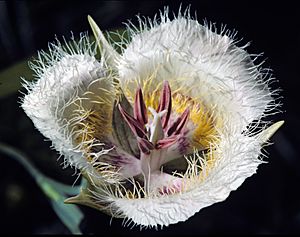Cox's mariposa lily facts for kids
Quick facts for kids Cox's mariposa lily |
|
|---|---|
 |
|
| Conservation status | |
| Scientific classification | |
| Genus: |
Calochortus
|
| Species: |
coxii
|
The Calochortus coxii, also known as Cox's mariposa lily, is a very rare flowering plant. It belongs to the lily family. This special lily is found only in Oregon in the United States. Specifically, it grows only in Douglas County. Scientists first described this plant in 1988.
Contents
About Cox's Mariposa Lily
What It Looks Like
Cox's mariposa lily is a plant that comes back every year. It grows about 15 to 25 centimeters (6 to 10 inches) tall. Its leaves are narrow, up to 30 centimeters long. The top of the leaves are hairy, while the undersides are smooth and shiny.
The plant produces 1 to 7 beautiful, bell-shaped flowers. Each petal can be up to 2.5 centimeters long. They are white with red stripes. There's also a large lavender spot near the base of each petal. Inside, the petals are covered in long, soft yellow and white hairs. These lilies bloom in the middle of summer. When the plant isn't flowering, it becomes dormant. During this time, only a single leaf stays above the ground.
Where It Grows
This rare lily grows in a special type of rocky soil called serpentine soil. You can find it in the Klamath Mountains in southern Oregon. There are about eight groups of these plants. They are spread out along a serpentine ridge that is about 30 miles long. This area is near the South Umpqua River. All these groups of plants are connected, forming one large population.
The lily prefers open meadows. It also grows where meadows meet forests with different types of pine and fir trees. The plant thrives in places that haven't been disturbed. It likes areas covered with natural leaf litter and moss. Some of the trees found nearby include Jeffrey pine, Douglas fir, and Pacific madrone.
Why It's Rare
Cox's mariposa lily faces several challenges that make it rare.
Fire and the Lily
One big problem is fire suppression. This means people stop natural wildfires from burning. This lily naturally grows in places that often have fires. These fires help clear out larger plants. Without fires, bigger plants can grow too tall and block the sunlight the lily needs. Scientists believe the lily will become even rarer if natural fires continue to be stopped.
Problem Plants
Another threat comes from invasive species. These are plants that are not native to the area. They can take over and push out the native plants like the mariposa lily. Examples of these harmful plants include yellow starthistle and Canada thistle.
Human Impact
Many human activities also threaten the lily.
- Logging can damage the soil where the lily grows. However, careful logging might help clear some overgrown areas.
- Livestock grazing (animals eating plants) can hurt the lily's leaves. This makes it harder for the plant to reproduce. Now, these lilies are mostly found in places where animals don't graze.
- Other threats include Mining, building roads, using off-road vehicles, and people collecting the plants for gardens.
- Even native animals and insects can cause some damage by eating the lily's buds or other parts.


